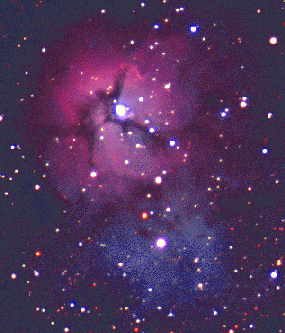Credit & Copyright: Hopkins Observatory, Karen Gloria
Explanation:
The vivid blue and violet colors present in the Trifid Nebula result
from the abundance of young stars there.
The light from young massive stars is quite blue and has the ability
to remove electrons from surrounding gas. When these electrons re-combine
with the gas, radiation rich in blue and violet light is emitted. Some
of the nebula's light also results from the reflection of star light off
of extremely small carbon specks known as 'dust'.
This object is known to astronomers as M20 - the twentieth object on
Charles Messier's
list of diffuse sky objects.
This image was taken with a 6-inch refracting
telescope.
For more information on M20 see The Electronic Universe Project's write-up.
Many images of Messier objects can be found in The Electronic Universe Project's The Galaxy Gallery: Messier Objects.
1999 2000 2001 2002 2003 2004 2005 2006 2007 2008 2009 2010 2011 2012 2013 2014 2015 2016 2017 2018 2019 2020 2021 2022 2023 2024 2025 |
Yanvar' Fevral' Mart Aprel' Mai Iyun' Iyul' Avgust Sentyabr' Oktyabr' Noyabr' Dekabr' |
NASA Web Site Statements, Warnings, and Disclaimers
NASA Official: Jay Norris. Specific rights apply.
A service of: LHEA at NASA / GSFC
& Michigan Tech. U.
|
Publikacii s klyuchevymi slovami:
Trifid nebula - M 20 - Trehrazdel'naya tumannost' - otrazhatel'nye tumannosti
Publikacii so slovami: Trifid nebula - M 20 - Trehrazdel'naya tumannost' - otrazhatel'nye tumannosti | |
Sm. takzhe:
Vse publikacii na tu zhe temu >> | |
